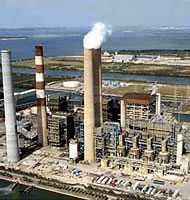![]()
Chapter 4.
Installing 7,000
Repowering and upsizing
o
(Below)
Taichung, Taiwan, the world's largest supersized coal power plant, largest CO2
producer.
Part 2 Existing coal burning equipment.
A nuclear/coal/gas/oil power plant is quite possible.
Part 3
Part 7
_______________________________________________________________________
Introduction.
_______________________________________________________________________
DOING IT
Fixing the worst first. Where to begin ending Global Warming?
Its good to understand we are now solution-rich in our search for ways to end Global Warming. Its also good to know that coal burning power plants are big, stationary, well-known, sitting duck targets that are not going to run away. Making things even better, CARMA lists the latitude and longitude of all the plants in its 60,000 power plant database.
REPOWERING: Change power plant boiler from coal-burning to nuclear to retain value of relatively new, large and expensive capitol investment.
CARMA has identified
Global Warming's giant CO2-causing
boilers
The equipment needed to replace these boilers is commercially available from
Replacing the largest - the worst - first is the fastest and most cost-effective strategy
for ending Global Warming
Thinking Strategically About Repowering:
Thinking strategically
Despite the growing list of reactors that would serve us well, its obvious the world cannot ignore CARMA's message: "Get the worst first."
This is the only way we are going to take out Global Warming.
Appropriate tactics for an effective assault on Global Warming: It takes very little more effort to convert the largest coal-burning power plant in the world to nuclear than a relatively small one and the resulting Global Warming CO2 mitigation payback is much greater. We should heed the lesson we are learning from building ineffective renewables and not squander our efforts repowering any but the largest power plants. Coal-burning power plants are much the same the world over. The only Global Warming fighting weapons the world needs for the foreseeable future is a specialized line of repowering reactors and steam generators based upon the big Russian Rosatom BN-800.
Building a windmill does not destroy a coal-burning boiler. Repowering a coal-burning power plant does. Wind produces little electricity and no heat. Building a windmill simply allows coal and natural gas-burning boilers to survive to pollute another day. Windmills are very tiny compared to coal-burning power plants.
________________________________________________________________
________________________________________________________________
________________________________________________________________

Introduction. Most of Global Warming happens in the world's large stationary boilers. Most of them are out of sight, largely forgotten, making CO2 all day, every day.
Global Warming's 12 Giga tonnes of CO2 per year - is slightly less than the 15.9 Giga tonnes of CO2 per year coming from only coal and natural gas - which is burned almost exclusively in the world's 1 billion boilers
(Right) Oblique view of Big Bend, an average U.S. supersized coal burning power plant.
_______________________________________________________________________
Converting your neighborhood coal plant to nuclear. The world's 1,200
supersized power plants that must be converted to nuclear to end Global Warming are large facilities usually
located on several thousand acre plots of land in areas zoned industrial.
They are always located next to
substantial bodies for cooling water and, of course, large numbers of high voltage
electrical grid towers, a substantial road, and railroad tracks.
There is a supersized coal burning power plant not far from my neighborhood (names are fictitious but everything else is real).
I can see the tops of